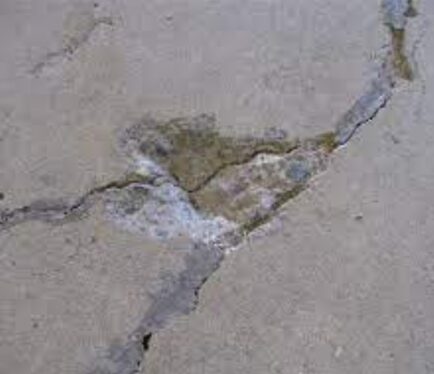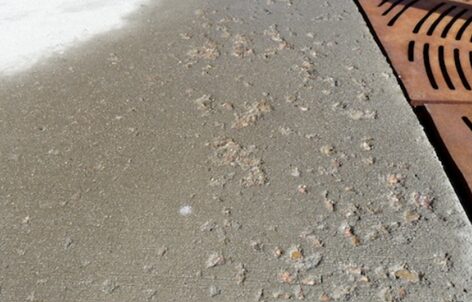Pop-out is a conical or cone-shaped fragment of concrete that breaks from the concrete surface, once the pop-out is taken out we can see a part of the broken aggregate at the bottom. They may occur at any time after construction; pop-out concrete may occur in a few hours of completion or in a few years.
Pop-out concrete varies in size from approximately 5 mm to 50 mm and may get to be as large as 300 mm at times as well. While pop-out concrete may be aesthetically displeasing however, it does not reduce the strength bearing capacity of a structure.
Table of Contents
Types of Pop-Out on Concrete Structures
It is important to identify the type of pop-out that has occurred so that appropriate measures can be taken to repair them or prevent them in future construction. Some of them are:
- Small surface pits
- Conical pop-out
- Crater-like pop-outs
- Aggregate pop-outs
- Moisture-induced pop-outs
- Ice lens pop-outs
Causes of Pop-Out on Concrete Surface
Causes of pop-out can be divided into two main categories: physical and chemical.
Physical Fracture
Pop-outs are mainly caused due to the poor quality aggregates; porous aggregates which have relatively low specific gravity and high moisture absorbent content are the main reason for the pop-out on concrete surface.
The poor quality aggregate absorbs moisture, during moisture conditions or curing period. The water absorbed inside the porous aggregate may freeze and expand causing swelling and internal pressure, eventually causing the surface of concrete to rupture. This type is generally referred to as moisture-induced pop-outs.
In colder weather, the water that enters the porous aggregates goes through a repeated cycle of freezing and thawing of water which causes ice lenses to develop. As these ice lenses expand, it causes pop-out on the concrete surface. This phenomenon may be referred to as the Freeze-Thaw Cycle.

Figure 2: Pop-Out on Concrete Surface
Another reason for the formation of pop-outs may be due to poor workmanship, as poorly finished surfaces or overworking the surface during finishing leads to the development of weak zones, causing concrete to pop-out in those zones.
Chemical Fracture
Sometimes pop-outs may occur due to the expansive reactivity between the alkali hydroxides present in cement (may be from any other source as well) and silica present in aggregates also referred to as alkali-silica reaction (ASR).
What basically happens is that an environment of high pH is developed due to the presence of high concentration of hydroxide ions (OH ions). The alkali reacts with silica forming ASR gel. Now, this ASR gel absorbs any moisture present and expands due to a small amount of concrete being removed along with it.
Pop-outs due to this type of fracture occur mostly within the year of the final setting of concrete; they may occur even in a few hours after the final setting or weeks but always within a year.
It is important to identify the cause and type of pop-out on the concrete surface in order to practise effective remedies for its elimination.
Effects of Pop-Out Concrete
Although the structural capacity of the member is not decreased due to pop-out on concrete surface however:
- It does not look aesthetically appealing. Additionally, sometimes due to chemical fractures or moisture induced fracture there might discoloration which makes it even more visually displeasing.
- In case of concrete pavements with heavy pedestrian traffic, tripping hazards are created due to pop-out on concrete surfaces.
- Even though structural capacity is not compromised, but the durability might be compromised if the pop-out is not treated as it locally weakens the concrete.
How to Prevent the Formation of Pop-Out on Concrete Surfaces?
The cement used should be according to ASTM standards with the least possible water content and permitted slump value.
- Air-entrained concrete should be used; air contents should be around 5% to 8%.
- Avoid finishing concrete with bleed water on the surface, flush the concrete surface before final drying.
- To reduce chemical fractures, cover the surface with plastic sheets after bull-floating during hot, dry and windy weather, to prevent the alkali from migrating to the surface and reacting with the silicon.
- Properly seal the concrete surface after 28 days of placing concrete.
- Properly cure the concrete surface, approximately 7 days of wet curing is advised.
- Use non-reactive agents to prevent expansion and eventual pop-out due to alkali and silicon reactions.
- Quality control should be implemented on every step, i.e. concrete mixing, placing and curing process.
How to Repair Pop-Out on Concrete Surfaces?
- Chip out the remaining portion of the aggregate remaining in the cavity.
- Clean the resulting void.
- Fill the void with a suitable repair material such as dry pack mortar, epoxy mortar etcetera.
However, the colour of the filled void might be difficult to match with the colour of the existing concrete structure.
Moreover, if there are numerous pop-outs that may be too cumbersome to fill individually in that case, to restore the uniformity of the concrete structure a thin bonded concrete overlay can be provided.
In conclusion, there are different types of pop-outs that appear on the surface on concrete structures which are not aesthetically pleasing.
They may occur due to physical aspects such as expansions due to different reasons, or they may occur due to chemical reactions between alkalis and silicon. However, we can take some preventive measures. to avoid pop-outs to occur. Additionally, we can also take measures to repair the developed pop-outs.





